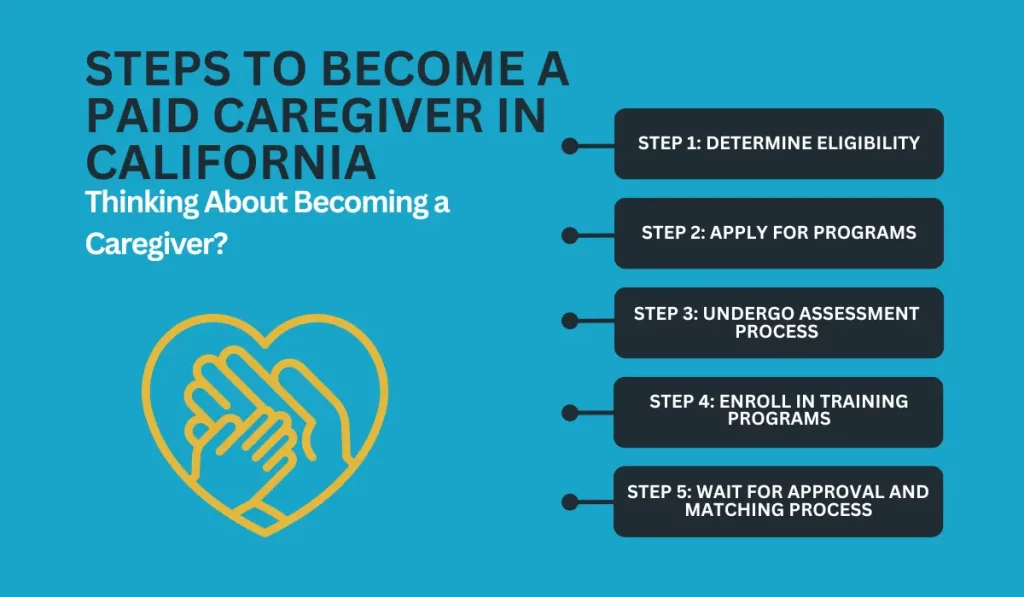How to Get Paid Taking Care of Elderly Parents in California

Table of Contents
Caring for a family member can be a rewarding yet demanding experience. In California, you have the opportunity to become paid caregivers for your loved ones.
This tailored approach to caregiving not only ensures that family members are properly cared for but also offers a viable career path if you want to dedicate yourself to this important work.
Whether you’re a seasoned caregiver or considering this path for the first time, navigate the intricacies of caregiving in California by finishing this article.
Key Takeaways
- Caregivers in California range from professional healthcare providers to unpaid family members, each offering unique forms of support based on the care recipient’s needs.
- Becoming a paid caregiver in California involves a series of steps, including determining eligibility, applying for programs, and completing mandatory training.
- Family caregivers have a range of responsibilities, from personal care and medication management to ensuring a safe living environment, highlighting the multifaceted nature of caregiving.
What Is a Caregiver?
A caregiver is an individual who provides an exceptional level of care and support to someone unable to fully care for themselves due to illness, disability, or age.
This role encompasses a wide range of responsibilities, from personal care and medical tasks to assistance with daily activities.
People who can fill this role include:
- professional healthcare providers
- adult children in the family
- friends and relatives
Caregivers play a crucial role in improving the quality of life for their care recipients, offering emotional support, companionship, and practical help.
Distinctions Between Caregivers
In California, there are several types of caregivers, each serving unique roles based on the needs of those they care for.
| Type of Caregiver | Description |
| Professional Caregivers | Paid care providers employed by agencies or healthcare facilities who offer care alternatives to nursing home care. |
| Family Caregivers | Unpaid individuals providing full-time care to a relative or friend with chronic illness, disability, or older adults. |
| Independent Caregivers | Directly hired by families or individuals, offering a personalized care approach outside of agency affiliation. |
| Home Health Aides (HHAs) | Provide basic healthcare and daily living assistance at their own homes under healthcare professional supervision. |
| Certified Nursing Assistants (CNAs) | Assist with daily activities and basic care in various settings under a licensed nurse’s supervision. |
| Respite Caregivers | Offer temporary relief for primary caregivers, available through home, adult day care centers, or residential care settings. |
| Hospice Caregivers | Specialize in providing comfort and support for terminally ill patients and their families at the end of life. |
| Palliative Care Caregivers | Focus on relieving illness symptoms and stress to improve the quality of life for patients and families. |
| Personal Care Assistants (PCAs) | Assist with daily personal tasks to support independence for individuals in their homes. |
Responsibilities as Family Caregivers
A family caregiver’s responsibilities include a wide range of self-directed tasks.
They provide personal care to their aging parents, which constitutes helping with activities of daily living (ADLs) such as bathing, dressing, and eating.
Other responsibilities may include:
- Medication management: Ensuring medicines are administered on time.
- Meal preparation: Cooking and ensuring dietary requirements are met.
- Housekeeping: Cleaning and maintaining a safe living environment.
Family caregivers also need to be aware of their rights, which protect them from undue stress and exploitation while they provide elder care.
What Are the Steps to Become a Paid Caregiver in California?

Becoming a paid caregiver in California involves several key steps to ensure you can provide professional care and support to your loved ones in need.
Step 1: Determine Eligibility
To become a paid family caregiver in California, you must first ensure you meet the eligibility requirements. You need to be authorized to work in the United States and pass a background check.
Recipients, typically family members with serious health conditions, must qualify for assistance programs like In-Home Supportive Services (IHSS) based on their income and need for in-home care.
Step 2: Apply for Programs
When applying, consider the broad range of service programs available, including those tailored to specific needs like the IHSS program or other state programs like California Paid Family Leave (PFL).
The application includes providing personal information, details about the recipient’s health condition, and the type of care required.
Forms are available online or at local Department of Social Services offices.
If you are a caregiver of veterans, exploring veteran-directed care programs is another option you can check. It includes all Veteran Affairs, such as:
- VA Medical Centers
- Veterans Aid
- Veterans Directed Home Care
Step 3: Undergo Assessment Process
After applying, an in-home assessment is scheduled to determine the recipient’s needs. A social worker evaluates the specific care requirements and the number of authorized care hours.
Step 4: Enroll in Training Programs
You may need to complete mandatory training and certification, depending on the program’s requirements. It might include:
- first aid
- safety protocols
- specialized care procedures
Information on training programs can be found through local community organizations or government programs.
Step 5: Wait for Approval and Matching Process
Once you complete the required training and the recipient’s needs are assessed, approval for the caregiver role is given.
You are then officially matched with your family members, allowing you to receive compensation for provided care through programs like IHSS, PFL, or veteran benefits.
Continual compliance with program rules, including accurate time reporting of caregiver services, is essential for continued participation.
This article is for information purposes only. Please do not call us for assistance as we are unable to help. Visit the California Employment Development Department website to find out which programs you or your loved one qualify for and to file a claim.
What Are the Required Qualifications and Training?
To become a paid caregiver for a family member in California, you need to meet certain qualifications and complete specific training programs.
Here’s a rundown of the basic requirements:
- Background Check: You must pass a criminal background check.
- Health Screening: A tuberculosis test and other health screenings may be required.
- Training Program: Completion of a state-approved caregiver training program is needed.
- CPR and First Aid Certification: These certifications are typically mandatory.
Essential Training Topics
You would undertake training that covers essential topics, including:
- Personal Care Services
- Patient Rights
- Safety Procedures
- Communication Skills
Enhancing Skills
Attending workshops and continued education in areas such as Alzheimer’s and dementia care or disability support improves caregiving skills.
Where to Find Support and Resources for Caregivers?
Caring for a family member can be rewarding but also demanding.
So, a caregiving guide is essential to support and provide resources available in California, ensuring your well-being and enhancing your caregiving abilities.
Accessing Respite Care and Training
Respite care is crucial if you need a break to recharge, especially if you care for a housebound family member.
In California, you can utilize services from area agencies, such as the California Caregiver Resource Centers.
Additionally, training is provided to enhance your skills and cope with specific disabilities. Resources for both respite care and training include:
- Home and Community-Based Services Waiver for the Developmentally Disabled (HCBS-DD): For tailored caregiver support.
- Long-term Care Insurance Policies: For coverage of the cost of respite services.
- “Cash and Counseling” Program: For stipend and financial assistance.
- The California Department of Aging: For access to information and care programs.
Finding Community and Emotional Support
Your emotional well-being is paramount to prevent burnout. Here are ways to connect with others and find the necessary emotional support:
- Engage with local support groups specifically for caregiving families.
- Reach out to California Caregiver Resource Centers for emotional support.
- Inquire about counseling services to address caregiver burnout.
- Look for organizations like the American Association of Retired Persons (AARP) and Area Agencies on Aging (AAA) that offer extensive support networks and resources.
What Are Financial and Legal Considerations?
Financial Programs
You may explore Medicaid programs (Medicare), which offer additional support and resources. The Aid & Attendance benefit is another important consideration if you care for veterans.
Managing Finances
You should also consider managing your financial responsibilities carefully to avoid any legal issues.
| Consideration | Why It’s Important |
| Accurate Records | Helps in managing finances and proving your income. |
| Tax Knowledge | Ensures compliance with state and federal laws. |
| Caregiving Agreement | Clarifies expectations and responsibilities. |
Legal Documents
Ensuring all legal documents are in order is crucial.
- Power of Attorney: Provides legal authority to make decisions if the care receiver is unable to do so.
- Advanced Health Care Directive: Documents the care receiver’s healthcare wishes.
- Estate Plan: Assists in the future allocation of the care receiver’s assets.
What Are Your Legal and Ethical Responsibilities?
When acting as a paid caregiver for a family member in California, you need to be mindful of various legal responsibilities.
Legal Responsibilities
- Adherence to labor laws
- Proper employment contracts
- Accurate reporting of income for taxes
- Understanding of wage and hour requirements
- Health Insurance Portability and Accountability Act (HIPAA) compliance for patient privacy
Ethical Considerations
- Treat care recipients with respect
- Uphold their dignity
- Maintain clear boundaries
Professional Relationship
- Transparent communication about care plans
- Avoid conflicts of interest
- Keep professional boundaries
This article is for information purposes only. Please do not call us for assistance as we are unable to help. Visit the California Employment Development Department website to find out which programs you or your loved one qualify for and to file a claim.








